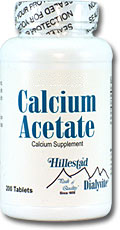Drug for today is calcium acetate.
What is calcium acetate indicated for?
INDICATIONS :
- It is indicated for the control of hyperphosphatemia in end stage renal failure and does not promote aluminum absorption.
- It is used to prevent high blood phosphate levels in patients who are on dialysis due to severe kidney disease. Dialysis removes some phosphate from your blood, but it is difficult to remove enough to keep your phosphate levels balanced. Decreasing blood phosphate levels can help keep your bones strong, prevent unsafe buildup of minerals in your body, and possibly decrease the risk of heart disease and strokes that can result from high phosphate levels.
How does calcium acetate work?
MECHANISMS OF ACTION :
It works by : -
- inducing reduction in the dietary intake of phosphate.
- inhibition of absorption of phosphate in the intestine with phosphate binders.
- removal of phosphate from the body by more efficient methods of dialysis.
How is calcium acetate taken?
ROUTE OF ADMINISTRATION :
- It is taken orally as tablets.
Dosage - Click here~
Is there any contraindication?
CONTRAINDICATIONS :
- It is contraindicated in patients with hypercalcemia.
Are there any possible side effects?
SIDE EFFECTS :
- Nausea.
- Hypercalcemia. Mild hypercalcemia (Ca> 10.5mg/dl) may be asymptomatic or manifest itself as constipation, anorexia, nausea and vomiting. More severe hypercalcemia (Ca> 12mg/dl) is associated with confusion, delirium, stupor and coma.
- Mild hypercalcemia is easily controlled by reducing the calcium acetate dose or temporarily discontinuing therapy. Severe hypercalcemia can be treated by acute hemodialysis and discontinuing calcium acetate therapy.
- Decreasing dialysate calcium concentration could reduce the incidence and severity of calcium acetate induced hypercalcemia.
- Isolated cases of pruritus(itchiness) have been reported which may represent allergic reactions.
What precautions are necessary?
PRECAUTIONS :
- Excessive dosage of calcium acetate induces hypercalcemia. Therefore, early in the treatment during dosage adjustment serum calcium should be determined twice weekly. Should hypercalcemia develop, the dosage should be reduced or the treatment discontinued immediately depending on the severity of hypercalcemia.
- Calcium acetate should not be given to patients on digitalis, because hypercalcemia may precipitate cardiac arrhythmias.
- Calcium acetate therapy should always be started at low dose and should not be increased without careful monitoring of serum calcium. An estimate of daily dietary calcium intake should be made initially and the intake adjusted as needed.
- Serum phosphorus should also be determined periodically.
- The patient should be informed :
- (i) about compliance with dosage instructions, adherence to instructions
- (ii) about diet and avoidance of the use of nonprescription antacids.
- (iii) about the symptoms of hypercalcemia.
DRUG INTERACTION :
- Calcium acetate may decrease the bioavailability of tetracyclines.
Pregnancy and breastfeeding:
- Animal reproduction
- studies have not been conducted with calcium acetate. It is also not known whether calcium acetate can cause fetal harm when administered to a pregnant woman or can affect reproduction capacity. Calcium acetate should be given to a pregnant woman only if clearly needed.
- It is not known whether this drug is excreted in human milk. As a general rule, nursing should not be undertaken while the patient is on calcium acetate since it may be excreted in human milk.
WARNING :
- Patients with end stage renal failure may develop hypercalcemia when given calcium with meals.
- No other calcium supplements should be given concurrently with calcium acetate.
- Progressive hypercalcemia due to overdose of calcium acetate may be severe as to require emergency measures.
- Chronic hypercalcemia may lead to vascular calcification, and other soft-tissue calcification. The serum calcium level should be monitored twice weekly during the early dose adjustment period.
- The serum calcium times phosphate (CaXP) product should not be allowed to exceed 66.
- Radiographic evaluation of suspect anatomical region may be helpful in early detection of soft-tissue calcification.
References :




































0 comments:
Post a Comment